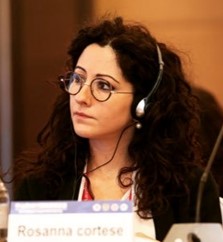https://doi.org/10.55788/0b76c918
For over 30 years, Prof. Catherine Lubetzki (Sorbonne University, France) has focused on studying re-myelination in MS, but thus far few studies yield any positive results [1]. Generally speaking, there are 2 strategies to promote myelin regeneration: exogenous and endogenous re-myelination. Exogenous re-myelination involves the transplantation of neural stem cells that have the potential to re-myelinate. Thus far, only 1 such study was performed in MS patients: a prospective, exploratory, open-label, phase 1 study (NCT03269071) of intrathecal transplantation of foetal-derived neural stem cells in patients with progressive MS. The study has been completed, but no results have yet been published at the time of the ECTRIMS 2022 meeting.
Endogenous re-myelination uses strategies to promote spontaneous re-myelination, which in MS is normally insufficient after a few years. A preclinical, proof-of-concept study showed that semaphorin 3F-transduced haematopoietic stem cells stimulated migration of oligodendrocyte progenitor cells [2]. “This is an important concept, showing that macrophages can be used as cellular vectors to deliver pro re-myelinating agents at the right place and at the right time,” said Prof. Lubetzki.
Prof. Lubetzki went on to show that numerous drug trials with the aim of promoting re-myelination for the most part failed to meet their objectives. Among the agents that have been or are currently tested, are bexarotene, opicinumab, clemastine, bazedoxifene, and gold nanocrystals. Possible explanations for the negative results could be an incorrect choice of study targets, populations, and/or markers in these studies, or an insufficient number of preclinical studies with functional outcomes.
There is a need for more markers to monitor re-myelination and more primary outcomes. “We should also think very carefully about the selection of patients,” said Prof. Lubetzki. “I think we can agree that it is not useful to include patients with primary progressive MS, because they have too much axonal pathology. Instead, we should focus on relapsing-remitting MS and optic neuritis. We should include patients under 45 years of age, who have had the disease for less than 5 years, and perhaps focus on good re-myelinators.” Optic neuritis patients are an interesting group, since re-myelination and neuroprotection can be assessed by using spectral-domain optical coherence tomography and visual evoked potentials. “But is optic neuritis the same thing as MS?”
PS: For this last topic, see also the piece on optic nerve lesions as a fifth element for dissemination in space in MS, in the chapter on diagnosis and prediction of disease course.
- Lubetzki C. Towards promoting remyelination in clinic. Scientific Session 3: Remyelination, ECTRIMS 2022, 26–28 October, Amsterdam, the Netherlands.
- Aigrot M-S, et al. EMBO Mol Med. 2022;14(8):e14759.
Copyright ©2022 Medicom Medical Publishers
Posted on
Previous Article
« MS associated with a broader Epstein-Barr virus specific T-cell receptor repertoire Next Article
Letter from the Editor »
« MS associated with a broader Epstein-Barr virus specific T-cell receptor repertoire Next Article
Letter from the Editor »
Table of Contents: ECTRIMS 2022
Featured articles
Letter from the Editor
Diagnosis and Prediction of Disease Course
A case for including optic nerve lesions in the McDonald criteria
Cerebrospinal fluid kappa-free light chains for MS diagnosis
Early, non-disabling relapses increase disability accumulation
Physical impairment is present before perceived MS onset
Chronic active MS lesions respond poorly to anti-CD20 antibodies
Treatment: Trials & Strategies
Dimethyl fumarate reduces the risk of a first clinical event in RIS
How and when to make a timely switch to high-efficacy DMT
Comparing real-world effectiveness of DMTs
Study fails to show non-inferiority of rituximab to ocrelizumab
Autologous haematopoietic stem cell transplantation versus DMTs
Progressive MS
Stem cell transplantation not superior to natalizumab in progressive MS
Efficacy of DMTs fades away in secondary progressive MS
Smartphone tapping can help detect progressive MS
Paediatric MS
Early treatment with DMT effective in paediatric-onset MS
Fingolimod in paediatric MS: results of up to 6 years
Switching treatment after initial platform injectable DMT: real-world data
Pregnancy
Pregnancy and infant outcomes in women receiving ocrelizumab
New safety data of anti-CD20 mAbs around pregnancy
MS activity and pregnancy outcomes after long-term use of natalizumab
NMOSD
Ravulizumab significantly reduced relapses in AQP4+ NMOSD
NMOSD patients are cognitively impaired regardless of serostatus
Evidence-based consensus on pregnancy in NMOSD
COVID-19
COVID-19 and MS: lessons learned thus far
Ocrelizumab and fingolimod increase the risk of COVID-19 and of worse outcomes
Humoral and cellular immune responses after SARS-CoV-2 vaccination
Miscellaneous
Re-myelination strategies in MS still pose many unanswered questions
MS associated with a broader Epstein-Barr virus specific T-cell receptor repertoire
Cognitive rehab and mindfulness reduce cognitive complaints in MS
© 2024 Medicom Medical Publishers. All rights reserved. Terms and Conditions | Privacy Policy
HEAD OFFICE
Laarderhoogtweg 25
1101 EB Amsterdam
The Netherlands
T: +31 85 4012 560
E: publishers@medicom-publishers.com


